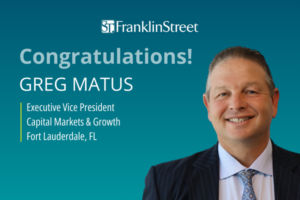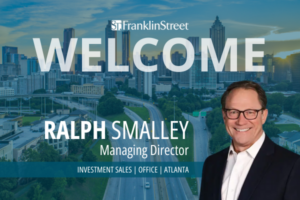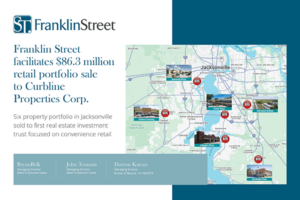Retail is in flux but these disruptive challenges will undoubtedly become opportunities as retailers and real estate adjust to the new normal. Some of these key trends include e-commerce, destination retail, entertainment-themed centers, lifestyle hubs and a shift to neighborhood centers, away from the traditional suburban mall.
E-commerce sales comprise about 11% of total retail sales and have grown 1,000% since 1993. “While there’s this huge growth in online consumption, we’re only losing about 6,000 stores on average per year to it,” according to Bill Rose, director, national retail group of Marcus & Millichap.
To that point, an interesting phenomenon has occurred where stores have adopted e-commerce to supplement brick-and-mortar operations to improve delivery times and efficiency and, in turn, Internet retailers have increasingly been dabbling in physical stores as a supplement to online sales. This is resulting in both sides converging in omni-channel customer access or “bricks within the clicks.”
Managing director Monetha Cobb of Franklin Street tells Real Estate Forum: “Omni-channel has proven to be more than a buzzword. Today, there are million ways to reach customers. With new space being delivered six to 12 months down the pipeline, retailers are using this time to figure out how to expand brands beyond brick-and-mortar locations. Conversely, online-only retailers are seeking brick-and-mortar space as well. There’s no one size fits all in the retail industry today, so retailers have to do it all— sell online, through physical locations, catalogs and pop-up shops —in order to keep shoppers constantly thinking about their brand. It’s causing retailers to get creative and will create some new opportunities in the future.”
With regard to new opportunities, it can be emphatically stated that retailers of music, books and travel are not likely to return. However, where the destination and entertainment component comes into play are those offerings not replaceable by the Internet.
Michael Comras, president and CEO of the Comras Co. tells Forum: “It’s not just the putting together of retailers, theaters, bowling alleys and restaurants. Entertainment is created not only by a wellcrafted co-tenancy, but the area that surrounds it. We often find that creating an effective ‘restaurant row’ not only provides a great activity node, but also serves as an anchor and a point of differentiation. Great public spaces with seating areas, fountains and a landscape where you can see and be seen—creates an environment that can’t be achieved by staying at home. The better the environment to entertain people, the easier it is to get them off their couch.”
To be sure, entertainment retail provides an opportunity for families to spend time together, rather than focusing on a computer screen in this era where people have less free time and want to be entertained.
Another factor is the influence of Millennials, whose retail consumption is motivated by ease of use and convenience. There are roughly 80 million Millennials with about $2.5 trillion in purchasing power, combined with around 75 million Baby Boomers, who have approximately $3 trillion in purchasing power. The crossover point will occur when Millennial purchasing power surpasses Boomer purchasing power; projected to occur in 2018, says Marcus & Millichap’s retail group. With spending power and consumption habits comes a change in retail trends.
“Millennials are very comfortable buying products on their smartphones. Old-line brands must continue to evolve in order to appeal to the consumers that are highly influenced by social media. The sneaker companies seem to really get it. Adidas is doing it with its Originals Superstar shoe and Converse is also doing it with its Chuck Taylor All Star II High Tops. The popularity that has come with the re-launch of the Polaroid-style cameras and vinyl music are other good examples,” Comras tells Forum
Beyond concept retail, the tried and true urban Main Street retailers will outperform other offerings, which fits with the migration of population into urban environments. Those choice locations, with access to transit, employment generators, healthcare facilities and entertainment, are winning over lackluster locales. Developments such as South Lake Union in Seattle and Bunker Hill in Los Angeles fit the description of the kind of walkable, amenity-laden neighborhoods that support high-end retailing.
According to Craig Trottier, senior vice president of retail development in Trammell Crow Co.’s Houston business unit, “Top-tier retail sites enjoyed robust demand and occupancy rates averaging more than 95%, while less favorable retail locations languished due, in part, to e-commerce and demographic changes, and a host of malls and shopping centers being actively redeveloped and rebranded to meet the needs and wants of today’s shopper.”
And what is becoming of those retail dinosaurs, the suburban malls? Some dollars and cents evidence shows that regional malls have average annual total returns of 14.2% and super-regional malls’ returns have been even higher at 16%. That is enough to keep attracting capital.
However, prime sites have long since been developed and regulatory hurdles to development have gotten more challenging since the last generation of mall building, says ULI. And simply, there are a number of dead B and B-minus malls to be rehabbed or demolished during the next few years.
Comras says, “In Miami, we are seeing urbanization of areas that were once considered suburban. Many concepts that started in urban areas are now moving into more dense suburban markets. More sophisticated lifestyle uses such as juice bars, blowdry bars, Soul Cycle and coffee purveyors are weaving themselves into suburban markets. Today, it’s not all about credit tenants. It’s more about a balance that will create the ideal environment with a sense of place.”
One thing is certain: Any future construction activity is tempered from lessons learned in the past. John Chang, first vice president, research services at Marcus & Millichap, says, “One of the biggest benefits to the retail sector is that construction is about 30% of the pre-recession levels. Excess space is being absorbed. Retail property vacancies have decreased to around 6%, which is close to where vacancy was in the last cycle. Modest construction is really giving the sector an opportunity to recover.”
Bill Hughes, SVP at Marcus & Millichap Capital Corp., agrees. “I think the anchor to all of this is banks are being more disciplined and that the Fed is requiring banks taking loans in the construction category to maintain pretty good balances against them. So you’re not going to see a free flow of money into that sector allowing anybody to build any project they want to build, leading to an oversupply of product.”
Along with measured construction comes a measured forecast from Trottier: “Even though retail is trailing other property types for investment gains, its growth in debt and equity activity is notable and investment is outpacing pre-recession levels. Completions will continue to be modest in 2016, projected to be 16.3 million square feet, with new supply arriving in more sizeable amounts in 2017, around 37 million square feet. Economic drivers such as employment growth, economic growth, rising incomes and savings from low gasoline prices will drive consumer activity and should call for a demand for space from retailers. However, should the financial market instability persist and reach the consumer, such a bright forecast may be considerably dampened.”



